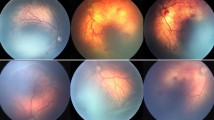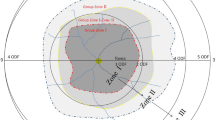Abstract
Purpose
To compare laser photocoagulation and intravitreal injection of bevacizumab (IVB) treatment for retinopathy of prematurity (ROP).
Methods
The study included 52 eyes of 26 patients after ROP treatment who were observed up to 5 years of age. Twenty-eight eyes received laser photocoagulation as the initial treatment (laser group), and twenty-four eyes underwent IVB (IVB group). We collected data on gestational age, birth weight, 1- and 5-min Apgar scores, zone and stage at the time of treatment, recurrence of ROP and best-corrected visual acuity (BCVA) (logMAR), equivalent spherical value (SE), ocular complications, and developmental delay at the age of 5.
Results
More zone I low-stage eyes were treated with IVB than laser. There was no difference in BCVA (p = 0.836). Although the mean SE was not different between the groups (p = 0.280), the prevalence of myopia was significantly higher in the laser group (p = 0.020). Developmental delay was observed in 3 of 14 and 3 of 12 cases in the laser and IVB groups, respectively (p = 0.596). Retinal holes were observed in 2 eyes in the IVB group, with 1 developing localized retinal detachment. There were no significant differences between the groups in the other factors.
Conclusions
Compared to laser for ROP, IVB was not inferior in neurodevelopment or visual outcome and was superior in refractive error. As cases in the IVB group showed retinal holes, long-term follow-up with fundus examination is recommended after IVB.


Similar content being viewed by others
References
Hartnett ME, Penn JS (2012) Mechanisms and management of retinopathy of prematurity. N Engl J Med 367:2515–2526
Hurley BR, McNamara JA, Fineman MS et al (2006) Laser treatment for retinopathy of prematurity: evolution in treatment technique over 15 years. Retina 26:S16–S17
Geloneck MM, Chuang AZ, Clark WL et al (2014) Refractive outcomes following bevacizumab monotherapy compared with conventional laser treatment: a randomized clinical trial. JAMA Ophthalmol 132:1327–1333
McLoone E, O’Keefe M, McLoone S, Lanigan B (2007) Effect of diode laser retinal ablative therapy for threshold retinopathy of prematurity on the visual field: results of Goldmann perimetry at a mean age of 11 years. J Pediatr Ophthalmol Strabismus 44:170–173
Mutlu FM, Sarici SU (2013) Treatment of retinopathy of prematurity: a review of conventional and promising new therapeutic options. Int J Ophthalmol 6:228–236
Chung EJ, Kim JH, Ahn HS, Koh HJ (2007) Combination of laser photocoagulation and intravitreal bevacizumab (Avastin) for aggressive zone I retinopathy of prematurity. Graefes Arch Clin Exp Ophthalmol 245:1727–1730
Mintz-Hittner HA, Kennedy KA, Chuang AZ, BEAT-ROP Cooperative Group (2011) Efficacy of intravitreal bevacizumab for stage 3+ retinopathy of prematurity. N Engl J Med 364:603–615
Mueller B, Salchow DJ, Waffenschmidt E et al (2017) Treatment of type I ROP with intravitreal bevacizumab or laser photocoagulation according to retinal zone. Br J Ophthalmol 101:365–370
Sarlos S, Rizkalla B, Moravski CJ, Cao Z, Cooper ME, Wilkinson-Berka JL (2003) Retinal angiogenesis is mediated by an interaction between the angiotensin type 2 receptor, VEGF, and angiopoietin. Am J Pathol 163:879–887
Rosenstein JM, Krum JM, Ruhrberg C (2010) VEGF in the nervous system. Organogenesis 6:107–114
Lepore D, Quinn GE, Molle F et al (2014) Intravitreal bevacizumab versus laser treatment in type 1 retinopathy of prematurity: report on fluorescein angiographic findings. Ophthalmology 121:2212–2219
Morin J, Luu TM, Superstein R et al (2016) Neurodevelopmental outcomes following bevacizumab injections for retinopathy of prematurity. Pediatrics 137:e20153218
Kennedy KA, Mintz-Hittner HA (2018) Medical and developmental outcomes of bevacizumab versus laser for retinopathy of prematurity. J AAPOS 22:61–65.e1
Lien R, Yu MH, Hsu KH et al (2016) Neurodevelopmental outcomes in infants with retinopathy of prematurity and bevacizumab treatment. PLoS One 11:e0148019
International Committee for the Classification of Retinopathy of Prematurity (2005) The international classification of retinopathy of prematurity revisited. Arch Ophthalmol 123:991–999
Good WV, Early Treatment for Retinopathy of Prematurity Cooperative Group (2004) Final results of the Early Treatment for Retinopathy of Prematurity (ETROP) randomized trial. Trans Am Ophthalmol Soc 102:233–250
Flitcroft DI, He M, Jonas JB et al (2019) IMI - Defining and classifying myopia: a proposed set of standards for clinical and epidemiologic studies. Invest Ophthalmol Vis Sci 60:M20–M30
Kawabe K, Kondo S, Matsumoto M et al (2016) Developmental quotient to estimate intelligence in autism spectrum disorder. Pediatr Int 58:963–966
Koyama T, Osada H, Tsujii H, Kurita H (2009) Utility of the Kyoto Scale of Psychological Development in cognitive assessment of children with pervasive developmental disorders. Psychiatry Clin Neurosci 63:241–243
Shibasaki J, Mukai T, Tsuda K et al (2020) Outcomes related to 10-min Apgar scores of zero in Japan. Arch Dis Child Fetal Neonatal Ed 105:64–68
Hwang CK, Hubbard GB, Hutchinson AK, Lambert SR (2015) Outcomes after intravitreal bevacizumab versus laser photocoagulation for retinopathy of prematurity: a 5-year retrospective analysis. Ophthalmology 122:1008–1015
Lee YS, See LC, Chang SH et al (2018) Macular structures, optical components, and visual acuity in preschool children after intravitreal bevacizumab or laser treatment. Am J Ophthalmol 192:20–30
Lepore D, Quinn GE, Molle F et al (2018) Follow-up to age 4 years of treatment of type 1 retinopathy of prematurity intravitreal bevacizumab injection versus laser: fluorescein angiographic findings. Ophthalmology 125:218–226
Hamad AE, Moinuddin O, Blair MP et al (2020) Late-onset retinal findings and complications in untreated retinopathy of prematurity. Ophthalmol Retina 4:602–612
Yoon JM, Shin DH, Kim SJ et al (2017) Outcomes after laser versus combined laser and bevacizumab treatment for type 1 retinopathy of prematurity in zone I. Retina 37:88–96
Snyder LL, Garcia-Gonzalez JM, Shapiro MJ, Blair MP (2016) Very late reactivation of retinopathy of prematurity after monotherapy with intravitreal bevacizumab. Ophthalmic Surg Lasers Imaging Retina 47:280–283
Gnanaraj L, Brennan R, Cottrell DG (2003) Retinopathy of prematurity in practice II: long-term results following treatment for threshold disease. Eye (Lond) 17:189–193
Wu WC, Kuo HK, Yeh PT, Yang CM, Lai CC, Chen SN (2013) An updated study of the use of bevacizumab in the treatment of patients with prethreshold retinopathy of prematurity in Taiwan. Am J Ophthalmol 155:150–158.e1
Gerber HP, Hillan KJ, Ryan AM et al (1999) VEGF is required for growth and survival in neonatal mice. Development 126:1149–1159
Walsh MC, Morris BH, Wrage LA et al (2005) Extremely low birthweight neonates with protracted ventilation: mortality and 18-month neurodevelopmental outcomes. J Pediatr 146:798–804
Novitskaya ES, Dahlmann-Noor AH, Adams GGW, Allen LE (2020) Retinopathy of prematurity treatment in the UK: trends in neonatal anaesthetic support and location of treatment from a national surveillance study. Eur J Pediatr. 179:1603–1607
Honda S, Hirabayashi H, Tsukahara Y, Negi A (2008) Acute contraction of the proliferative membrane after an intravitreal injection of bevacizumab for advanced retinopathy of prematurity. Graefes Arch Clin Exp Ophthalmol. 246:1061–1063
Author information
Authors and Affiliations
Contributions
Design of the study (T.M., A.K., M.N., Y.M., and T.O.); conduct of the study (T.M., Y.S., Y.O., and A.K.); data collection (T.M., F.O., S.H., and M.N.); management, analysis, and interpretation of the data (T.M., F.O., S.H., and M.N.); preparation of the manuscript (T.M. and Y.S.); review of the manuscript (F.O. and T.O.); approval of the manuscript (Y.O., A.K., S.H., M.N., and Y.M.,).
Corresponding author
Ethics declarations
Ethical approval
All procedures performed in studies involving human participants were in accordance with the ethical standards of the institutional and/or national research committee and with the 1964 Helsinki Declaration and its later amendments or comparable ethical standards.
Consent to participate
Informed consent was obtained from all individual participants included in the study.
Consent for publication
Informed consent was obtained from all individual participants included in the study.
Conflict of interest
The authors declare no competing interests.
Additional information
Publisher’s note
Springer Nature remains neutral with regard to jurisdictional claims in published maps and institutional affiliations.
Rights and permissions
About this article
Cite this article
Murakami, T., Sugiura, Y., Okamoto, F. et al. Comparison of 5-year safety and efficacy of laser photocoagulation and intravitreal bevacizumab injection in retinopathy of prematurity. Graefes Arch Clin Exp Ophthalmol 259, 2849–2855 (2021). https://doi.org/10.1007/s00417-021-05137-9
Received:
Revised:
Accepted:
Published:
Issue Date:
DOI: https://doi.org/10.1007/s00417-021-05137-9




